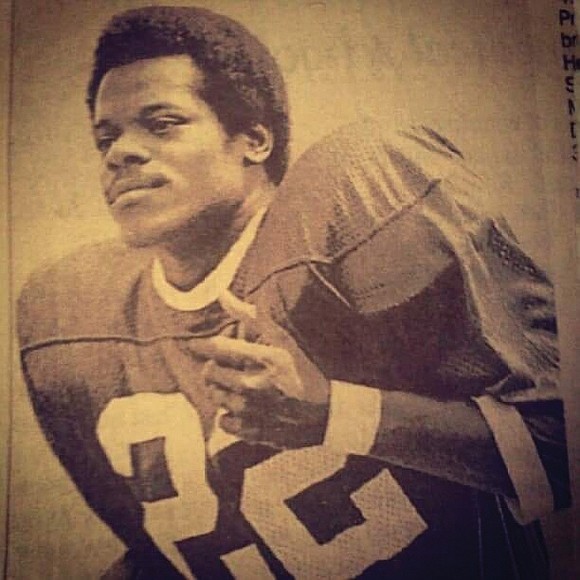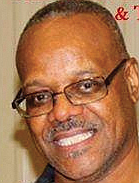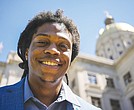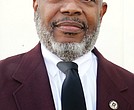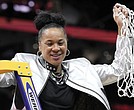Weldon Edwards planted seeds as first black football player 50 years ago at UR
Fred Jeter | 4/23/2020, 6 p.m.
“Last August the University of Richmond signed its first Negro football player, Weldon Edwards,” so wrote Mark Holpe of The Collegian, UR’s campus newspaper, in 1970.
There’s now a lengthy list of African-American football players to have suited up for the University of Richmond.
But that list started with Weldon Edwards 50 years ago.
Coming out of Richmond’s Maggie L. Walker High School, Edwards had the right blend of size, speed and academics to convince UR Coach Frank Jones to break the color line at the campus.
Other schools courting Edwards were Dartmouth and the University of Pennsylvania from the Ivy League, as well as the University of Nebraska, Temple University and as far off as the University of Hawaii.
Edwards borrowed on his mother Amanda’s wisdom to make the groundbreaking choice.
“My mother worked at the Rotunda Club in the Jefferson Hotel and she knew a lot of UR people,” Edwards recalled. “She felt UR was the right school for me. Plus, she didn’t want me to go far from home.”
That same year, UR signed two more African-American athletes, Carlton Mack for basketball and Norman Williams for track and field.
Because football came before hoops and track, Edwards, wearing the No. 22 jersey, was the first African-American player to wear UR’s red, white and blue colors.
“I went from an all-black high school to an all-white college,” Edwards recalled.
After spending the 1970 football season on the freshmen team (freshmen weren’t eligible for varsity at the time), Edwards broke onto Coach Jones’ varsity with a bang, scoring two touchdowns in the 1971 season opener against the University of North Carolina.
Then came a cold slap of adversity.
In the Sept. 25, 1971, game against West Virginia University in Morgantown, Edwards suffered a major knee injury that would require total reconstruction.
“That one play changed my whole life,” he recalled.
Edwards missed the rest of the 1971 season and later was converted to defensive back, a position he excelled at but didn’t prefer.
“Coaches were looking out for my health. They were afraid I was hurt for life,” Edwards said. “They thought they were doing me a favor, but I didn’t see it that way. I had my speed back and wanted to run the ball.”
Listed at 6-foot-1 and 193 pounds, Edwards proved he had regained his speed by winning the Southern Conference 60-yard dash indoors in 1972. That earned him a berth in the NCAA Division I Nationals that year in Detroit.
While his three varsity seasons at UR didn’t go as planned, he still made some lifetime friends and was hired by Coach Jim Tait, who succeeded Coach Jones, as an assistant for three seasons.
The campus social life wasn’t ideal, Edwards recalled.
His first assigned roommate, who was from Florida, declined to share a dorm room with Edwards.
Rick Newell from Indiana then volunteered to room with Edwards, and the men became close friends.
“I went to a frat party once with other football players, but I could tell they didn’t want me there,” he said.
“On weekends, I mostly went to Virginia State, Virginia Union and VCU to party.”
Edwards mostly stuck to football and his books, earning a bachelor’s in sociology.
At Maggie L. Walker, Edwards starred in football and track for the Green Dragons under Coach Cannonball Cooper.
On the cinders, he posted personal bests of 9.5 seconds for 100 yards, 21.0 for 220 yards and 22 feet, 11 inches for the long jump.
He came along at the same time as two of the state’s premier all-time sprinters, Kent Merritt of Lane High School in Charlottesville and John Marshall High School’s Barney Cobb.
Edwards went on to compete in the National Junior Olympics in San Diego, which accounts for the nationwide recruitment directed his way.
Having fully healed from the knee surgery, Edwards had serious tryouts with Birmingham of the World Football League and the NFL team in Washington.
A car accident in which he re-injured the knee dealt his gridiron career another setback in 1974.
Edwards’ extreme athleticism led to him taking up other adult sports. He developed into a feared power hitter for some of the area’s top softball teams, most notably Virginia Roofing. That talented squad also featured Frank Dark and William Dillon, former VUU football play- ers, and Gene Cunningham, a former basketball player for Norfolk State.
Quickly adjusting to flag football, he was a break-away runner for some elite squads, including South Slope and the MCV Drillers with former NFL and UR standout Ray Easterling.
Edwards has spent most of his adult life in auto sales. He is now in his 14th year at The Auto Connection on Midlothian Turnpike. Previously, he was a sales manager at Richmond Ford.
African-American athletes have become marquee attractions for UR football. Tim Hightower, Shawn Barber, Brian Jordan, Barry Redden, Lawrence Sidbury, Leland Melvin and Arman Shields, among others, used UR as a springboard to the NFL.
But for anything to grow, a seed must be planted.
Don’t forget, it was Weldon Edwards who planted the seed of diversity at the University of Richmond.

